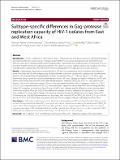Subtype-specific differences in Gag-protease replication capacity of HIV-1 isolates from East and West Africa
Author(s)
Farinre, Omotayo; Gounder, Kamini; Reddy, Tarylee; Tongo, Marcel; Hare, Jonathan; Chaplin, Beth; Gilmour, Jill; Kanki, Phyllis; Mann, Jaclyn K; Ndung’u, Thumbi; ... Show more Show less
Download12977_2021_Article_554.pdf (1.450Mb)
Publisher with Creative Commons License
Publisher with Creative Commons License
Creative Commons Attribution
Terms of use
Metadata
Show full item recordAbstract
Abstract
Background
The HIV-1 epidemic in sub-Saharan Africa is heterogeneous with diverse unevenly distributed subtypes and regional differences in prevalence. Subtype-specific differences in disease progression rate and transmission efficiency have been reported, but the underlying biological mechanisms have not been fully characterized. Here, we tested the hypothesis that the subtypes prevalent in the East Africa, where adult prevalence rate is higher, have lower viral replication capacity (VRC) than their West African counterparts where adult prevalence rates are lower.
Results
Gag-protease sequencing was performed on 213 and 160 antiretroviral-naïve chronically infected participants from West and East Africa respectively and bioinformatic tools were used to infer subtypes and recombination patterns. VRC of patient-derived gag-protease chimeric viruses from West (n = 178) and East (n = 114) Africa were determined using a green fluorescent protein reporter-based cell assay. Subtype and regional differences in VRC and amino acid variants impacting VRC were identified by statistical methods. CRF02_AG (65%, n = 139), other recombinants (14%, n = 30) and pure subtypes (21%, n = 44) were identified in West Africa. Subtypes A1 (64%, n = 103), D (22%, n = 35), or recombinants (14%, n = 22) were identified in East Africa. Viruses from West Africa had significantly higher VRC compared to those from East Africa (p < 0.0001), with subtype-specific differences found among strains within West and East Africa (p < 0.0001). Recombination patterns showed a preference for subtypes D, G or J rather than subtype A in the p6 region of gag, with evidence that subtype-specific differences in this region impact VRC. Furthermore, the Gag A83V polymorphism was associated with reduced VRC in CRF02_AG. HLA-A*23:01 (p = 0.0014) and HLA-C*07:01 (p = 0.002) were associated with lower VRC in subtype A infected individuals from East Africa.
Conclusions
Although prevalent viruses from West Africa displayed higher VRC than those from East Africa consistent with the hypothesis that lower VRC is associated with higher population prevalence, the predominant CRF02_AG strain in West Africa displayed higher VRC than other prevalent strains suggesting that VRC alone does not explain population prevalence. The study identified viral and host genetic determinants of virus replication capacity for HIV-1 CRF02_AG and subtype A respectively, which may have relevance for vaccine strategies.
Date issued
2021-05-05Department
Ragon Institute of MGH, MIT and HarvardPublisher
BioMed Central
Citation
Retrovirology. 2021 May 05;18(1):11
Version: Final published version